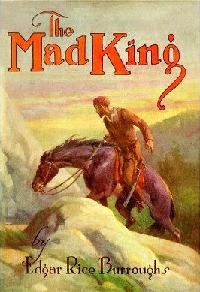
Edgar Rice Burroughs was an American writer, best known for his prolific output in the adventure, science fiction, and fantasy genres. Best known for creating the characters Tarzan and John Carter, he also wrote the Pellucidar series, the Amtor series, and the Caspak trilogy.

The Prisoner of Zenda is an 1894 adventure novel by Anthony Hope, in which the King of Ruritania is drugged on the eve of his coronation and thus is unable to attend the ceremony. Political forces within the realm are such that, in order for the king to retain the crown, his coronation must proceed. Fortuitously, an English gentleman on holiday in Ruritania who resembles the monarch is persuaded to act as his political decoy in an effort to save the unstable political situation of the interregnum.

John Carter of Mars is a fictional Virginian soldier who acts as the initial protagonist of the Barsoom stories by Edgar Rice Burroughs. A veteran of the American Civil War, he is transported to the planet Mars, called Barsoom by its inhabitants, where he becomes a warrior battling various mythological beasts, alien armies and malevolent foes. Created in 1911, the character has appeared in novels and short stories, comic books, television shows and films, including the 2012 feature film John Carter, which marked the 100th anniversary of the character's first appearance.
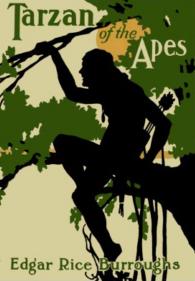
Tarzan of the Apes is a 1912 story by American writer Edgar Rice Burroughs, and the first in the Tarzan series. It was first printed in the pulp magazine The All-Story in October 1912 before being released as a novel in June 1914.
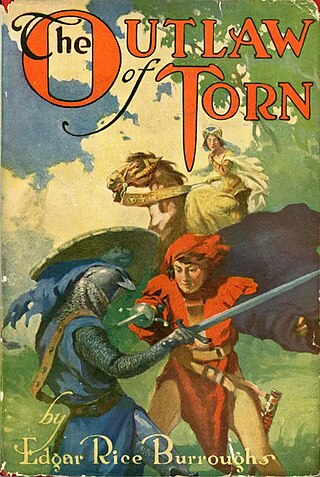
The Outlaw of Torn is a historical novel by Edgar Rice Burroughs, taking place in 13th century England.
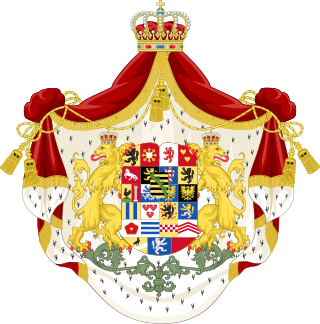
The House of Saxe-Coburg and Gotha is a European royal house. It takes its name from its oldest domain, the Ernestine duchy of Saxe-Coburg and Gotha, and its members later sat on the thrones of Belgium, Bulgaria, Portugal, and the United Kingdom and its dominions.
Opar is a fictional lost city in the Tarzan novels of Edgar Rice Burroughs and later the Khokarsa novels of Philip José Farmer and Christopher Paul Carey, as well as various derivative works in other media.
Kerchak is a fictional ape character in Edgar Rice Burroughs's original Tarzan novel, Tarzan of the Apes, and in movies and other media based on it.

Ruritanian romance is a genre of literature, film and theatre comprising novels, stories, plays and films set in a fictional country, usually in Central or Eastern Europe, such as the "Ruritania" that gave the genre its name.

Tarzan and the Ant Men is a novel by American writer Edgar Rice Burroughs, the tenth in his series of twenty-four books about the jungle hero Tarzan. It was first published as a seven-part serial in the magazine Argosy All-Story Weekly for February 2, 9, 16 and 23 and March 1, 8 and 15, 1924. It was first published in book form in hardcover by A. C. McClurg in September 1924. The story was also adapted for Gold Key Comics in Tarzan #174-175 (1968).
Kala is a fictional ape character in Edgar Rice Burroughs's original Tarzan novel, Tarzan of the Apes, and in movies and other media based on it. She is the ape mother of Tarzan who raises him.
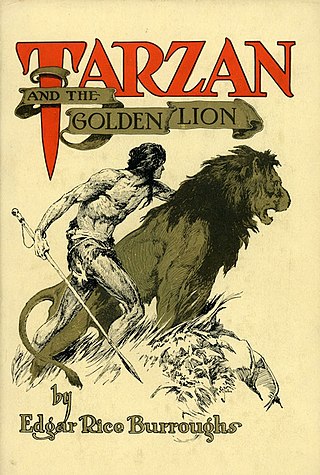
Tarzan and the Golden Lion is an adventure novel by American writer Edgar Rice Burroughs, the ninth in his series of twenty-four books about the title character Tarzan. It was first published as a seven part serial in Argosy All-Story Weekly beginning in December 1922; and then as a complete novel by A.C. McClurg & Co. on March 24, 1923.

Tarzan and the Lion Man is a novel by American writer Edgar Rice Burroughs, the seventeenth in his series of twenty-four books about the title character Tarzan. The novel was originally serialized in the magazine Liberty from November 1933 through January 1934.

The Eternal Lover is a fantasy-adventure novel by American writer Edgar Rice Burroughs. The story was begun in November 1913 under the working title Nu of the Niocene. It was first run serially in two parts by All-Story Weekly. The first part, released March 7, 1914 was titled "The Eternal Lover" and the second part, released in four installments from January 23, 1915 to February 13, 1915 was titled "Sweetheart Primeval". The book version was first published by A. C. McClurg on October 3, 1925. In 1963, Ace Paperback published a version under the title The Eternal Savage. An E-Text edition has been published by Edgar Rice Burroughs, Inc. and is available online.

Tarzan is a fictional character, a feral child raised in the African jungle by the Mangani great apes; he later experiences civilization, only to reject it and return to the wild as a heroic adventurer.

Tarzan is a series of 24 adventure novels written by Edgar Rice Burroughs (1875–1950) and published between 1912 and 1966, followed by several novels either co-written by Burroughs, or officially authorized by his estate. There are also two works written by Burroughs especially for children that are not considered part of the main series.

The Rider is a short Ruritanian romance by American writer Edgar Rice Burroughs. It was written in 1915 and first published as "H.R.H. the Rider" as a serial in All-Story Weekly from December 14–28, 1918. Its first book publication paired it with an unrelated tale, The Oakdale Affair, in The Oakdale Affair and The Rider, issued by Edgar Rice Burroughs, Inc. in February 1937 and subsequently reprinted by Grosset & Dunlap in 1937, 1938, and 1940. The story's first independent book publication was in a paperback edition from Ace Books in October 1974.
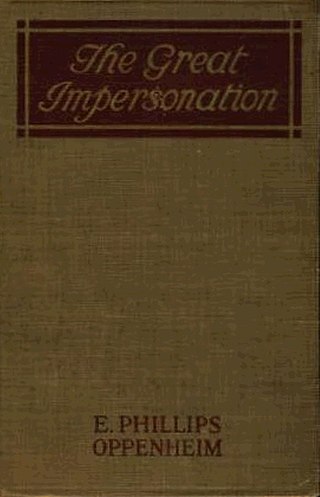
The Great Impersonation is a mystery novel written by E. Phillips Oppenheim and published in 1920. German Leopold von Ragastein meets his doppelganger, Englishman Everard Dominey, in Africa, and plans to murder him and steal his identity to spy on English high society just prior to World War I. However, doubts of the returned Dominey's true identity begin to arise in this tale of romance, political intrigue, and a (literally) haunting past.
Tublat is a fictional ape character in Edgar Rice Burroughs's original Tarzan novel, Tarzan of the Apes and one of its sequels, Jungle Tales of Tarzan, as well as animated films, television series and other media based on them.
